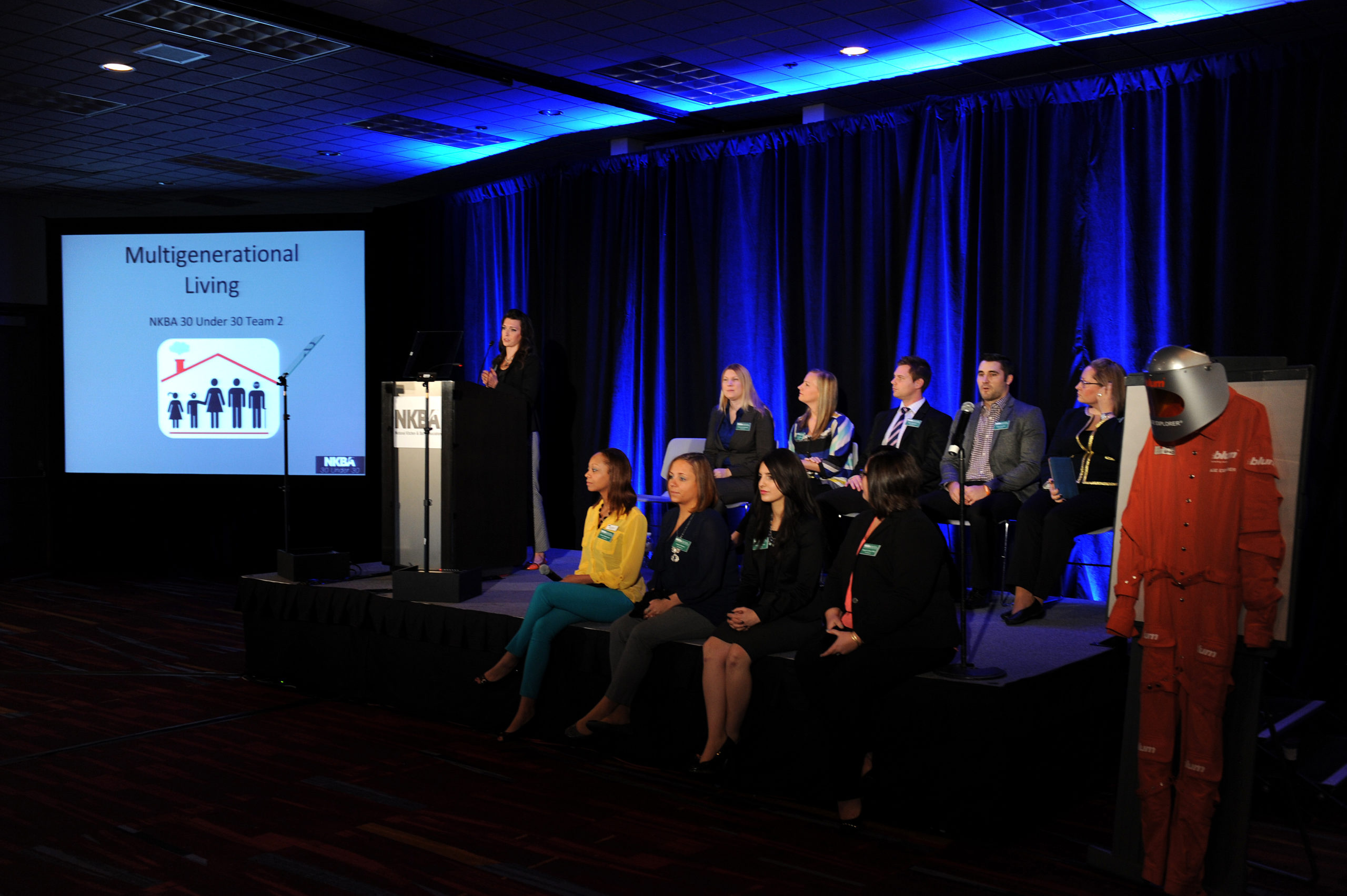At this year’s Kitchen & Bath Industry Show (KBIS®), the National Kitchen & Bath Association (NKBA) recognized the recipients of the 2014 “30 Under 30,” a group of young men and women who are still in their 20s but represent enthusiastic entrepreneurs, forward-thinking CEOs and cutting-edge designers.
“Gen Y has a great perspective on how our industry can thrive and refresh itself,” noted Alison DeMartino, Director, Marketing Communications for Wilsonart. “As a ‘30 Under 30’ Platinum Program sponsor, we wanted to share their insights on critical industry topics.” After scouring the show floor for innovations, trends and new technologies, the group offered these three perspectives, as captured in this video.
Team 1 – Who Are the Millennials?
Team 1 opted to give the audience an overview of their generation, what makes them tick and what gets them “ticked off.” The observations show opportunities for the industry to court the next generation of homeowners.
Millennials, otherwise known as Generation Y, were born in the 1980s and 1990s. They are a highly driven, impatient generation who admit that they sometimes have trouble with realistic timelines. They multi-task with numerous devices and thrive on knowing that they have options, options and more options. Some surprising findings from a survey of 100 Millennials showed:
• The hottest trend in kitchen design is “open concept kitchen and living spaces”
• Design ideas are most often sought from social media sites such as Houzz, Instagram and Pinterest
• Most popular color trend is “shades of gray”
The group commented that Millennials have “no realistic idea of how much a kitchen or bathroom renovation really costs.” Perhaps it’s the misleading HGTV home renovation shows or a lack of honest discussions, but education is clearly needed. Core to the advice was to help Gen Y understand the “sweet spot” between balancing their design “wants” with what their budget can handle. Some recommendations on how to educate them:
• Use their outlets, HGTV, Houzz, Instagram and Facebook
• Explain why quality is important
• Review the design and renovation process
Team 2 – Multigenerational Living
This is a huge marketplace and opportunity for the industry. An estimated 5.6 percent of the US’s 76 million households – or 4.3 million households – are considered “Multigenerational.” Since 1980, multigenerational households have been on the rise due to health and disability issues, financial burdens, including cost savings from healthcare/childcare, the rocky economy and “Boomerang” kids, a phrase used to describe today’s college graduates who are moving back home because they are out of work and in debt. Research shows that many homes are not designed to meet multi-gen living, which ideally requires privacy for the generations sharing a home and products specifically designed with elderly people in mind. For families where the age range might be newborn to 80, the manta is: “Know TODAY what the requirements might be TOMORROW.” So how does a Millennial designer understand just what it’s like to be “old?” Inventive Team 2 used the Blum Age Explorer, a space-suit-like outfit that simulates limitations – like sight failing, arthritis, lack of strength – that many people experience as they age. The implications for design and construction were everywhere and ranged from the need for ergonomic universal design to installing smart appliances and cabinets that opened with the touch of a hand through hinge technologies. The need for ADA-compliant construction and bathroom “must haves” like curb less and zero threshold tubs, thermostatic showers and easy-to-open-and-close cabinets and drawers were stressed. With 1.5 million Baby Boomers turning 65 each year for the next 15 years, innovation and new product development offer opportunities and implications across all sectors of the home industry.
#30_30TEAM3
Appropriately identified as a hashtag, Team 3 provided an overview of social media with advice on “dos” and “don’ts” for several social platforms. One glimpse at the graphic below shows how confusing social collaboration can be today:
Where to start? Thankfully, you don’t have to do everything. The group gave recommendations on a few key digital and social hubs instrumental to success today.
Company Website
The fundamental building block of online visibility, Team 3 urged starting with you company’s website. “Promote your brand, update regularly and make it professional” was the straightforward advice. And avoid making information “difficult to find” and be sure to use “professional images.” It’s important that the company website be the portal to connect with Facebook, Twitter and Houzz.
Facebook
Four key recommendations here: “Keep it current,” “monitor your posts,” “engage” (yes, answer the posts and engage with your fans who are making comments) and be sure to “connect Facebook with other social media.” On the “don’t” side the advice was to “don’t overload your fans with too much information” and “avoid mixing personal and professional news.”
Twitter
Make sure you “engage,” “promote your brand message,” “use bite size information” (that would be 140 characters maximum, less if you are hoping you will be re-tweeted), “participate” and “respond.” Things to avoid “unprofessional selfie’s” (better yet, avoid all selfie’s) and “too much information.” A good piece of advice was “don’t include Instagram links” (this feature is not yet available on Android phones so it’s best not to share until it is) and do not “ignore or sell” to your followers. It will turn them off.
Houzz
Houzz is a great resource for our industry and some tips to maximize it are to “include location information,” “post regularly,” “point people to your website” and “participate in conversations and discussions.” Remember don’t “ignore your competition,” “wait to reply to people” or “post unprofessional photos.”
By filling the social pipeline with your products, services and what makes you different, it will be easier to engage with, and sell, Millennial customers today.
The 2014 NKBA 30 Under 30 Program was sponsored by:
Platinum Sponsor: Wilsonart
Gold Sponsor: Danze

